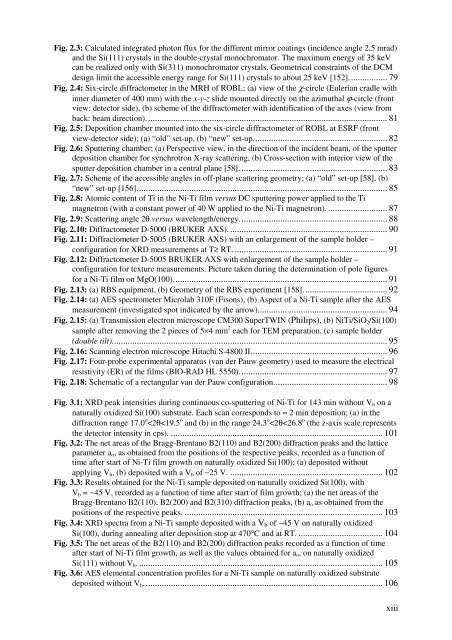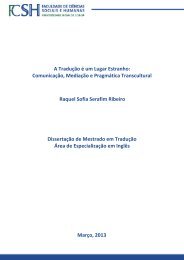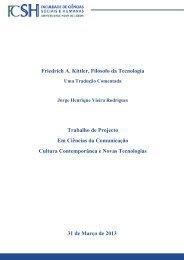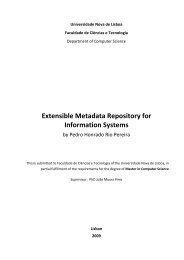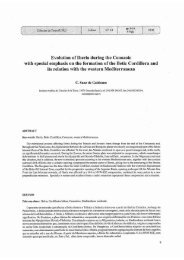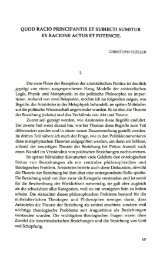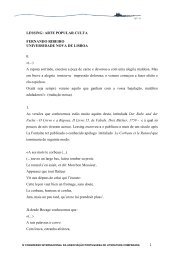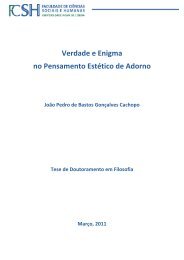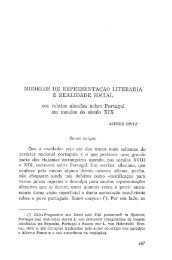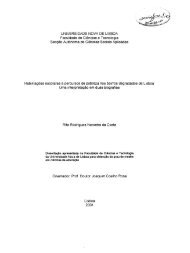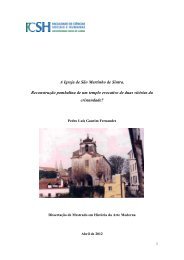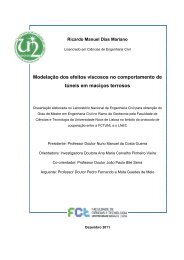PhD Thesis_RuiMSMartins.pdf - RUN UNL
PhD Thesis_RuiMSMartins.pdf - RUN UNL
PhD Thesis_RuiMSMartins.pdf - RUN UNL
You also want an ePaper? Increase the reach of your titles
YUMPU automatically turns print PDFs into web optimized ePapers that Google loves.
Fig. 2.3: Calculated integrated photon flux for the different mirror coatings (incidence angle 2.5 mrad)<br />
and the Si(111) crystals in the double-crystal monochromator. The maximum energy of 35 keV<br />
can be realized only with Si(311) monochromator crystals. Geometrical constraints of the DCM<br />
design limit the accessible energy range for Si(111) crystals to about 25 keV [152]. ................ 79<br />
Fig. 2.4: Six-circle diffractometer in the MRH of ROBL; (a) view of the χ-circle (Eulerian cradle with<br />
inner diameter of 400 mm) with the x-y-z slide mounted directly on the azimuthal ϕ-circle (front<br />
view: detector side), (b) scheme of the diffractometer with identification of the axes (view from<br />
back: beam direction). ......................................................................................................... 81<br />
Fig. 2.5: Deposition chamber mounted into the six-circle diffractometer of ROBL at ESRF (front<br />
view-detector side); (a) “old” set-up, (b) “new” set-up. .......................................................... 82<br />
Fig. 2.6: Sputtering chamber; (a) Perspective view, in the direction of the incident beam, of the sputter<br />
deposition chamber for synchrotron X-ray scattering, (b) Cross-section with interior view of the<br />
sputter deposition chamber in a central plane [58]. ................................................................ 83<br />
Fig. 2.7: Scheme of the accessible angles in off-plane scattering geometry; (a) “old” set-up [58], (b)<br />
“new” set-up [156]. ............................................................................................................. 85<br />
Fig. 2.8: Atomic content of Ti in the Ni-Ti film versus DC sputtering power applied to the Ti<br />
magnetron (with a constant power of 40 W applied to the Ni-Ti magnetron). .......................... 87<br />
Fig. 2.9: Scattering angle 2θ versus wavelength/energy. ................................................................ 88<br />
Fig. 2.10: Diffractometer D-5000 (BRUKER AXS). ..................................................................... 90<br />
Fig. 2.11: Diffractometer D-5005 (BRUKER AXS) with an enlargement of the sample holder –<br />
configuration for XRD measurements at T≥ RT. ................................................................... 91<br />
Fig. 2.12: Diffractometer D-5005 BRUKER AXS with enlargement of the sample holder –<br />
configuration for texture measurements. Picture taken during the determination of pole figures<br />
for a Ni-Ti film on MgO(100). ............................................................................................. 91<br />
Fig. 2.13: (a) RBS equipment, (b) Geometry of the RBS experiment [158]. .................................... 92<br />
Fig. 2.14: (a) AES spectrometer Microlab 310F (Fisons), (b) Aspect of a Ni-Ti sample after the AES<br />
measurement (investigated spot indicated by the arrow)......................................................... 94<br />
Fig. 2.15: (a) Transmission electron microscope CM300 SuperTWIN (Philips), (b) NiTi/SiO 2 /Si(100)<br />
sample after removing the 2 pieces of 5×4 mm 2 each for TEM preparation, (c) sample holder<br />
(double tilt). ........................................................................................................................ 95<br />
Fig. 2.16: Scanning electron microscope Hitachi S-4800 II. ........................................................... 96<br />
Fig. 2.17: Four-probe experimental apparatus (van der Pauw geometry) used to measure the electrical<br />
resistivity (ER) of the films (BIO-RAD HL 5550). ................................................................ 97<br />
Fig. 2.18: Schematic of a rectangular van der Pauw configuration. ................................................. 98<br />
Fig. 3.1: XRD peak intensities during continuous co-sputtering of Ni-Ti for 143 min without V b on a<br />
naturally oxidized Si(100) substrate. Each scan corresponds to ≈ 2 min deposition; (a) in the<br />
diffraction range 17.0 o


